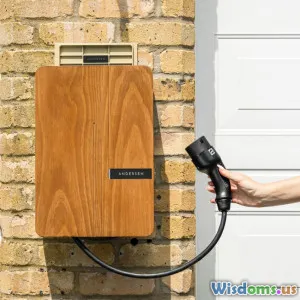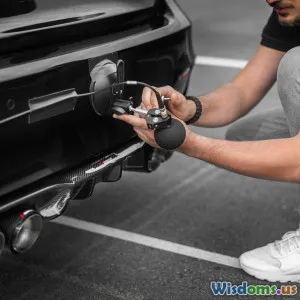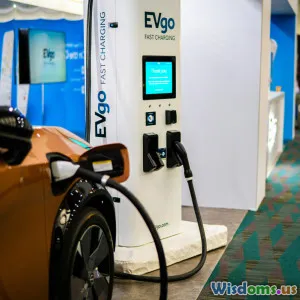
Five Surprising Facts About Hondas Eco Engineering
11 min read Discover five astonishing ways Honda leads the industry with innovative eco engineering solutions for greener mobility and sustainable technology. (0 Reviews)
Five Surprising Facts About Honda’s Eco Engineering
The pursuit of cleaner, more efficient transportation has pushed automotive giants to develop groundbreaking technologies—and few have innovated as persistently as Honda. Often seen as a leader in reliability and driver satisfaction, Honda’s deeper commitment to eco-friendly engineering is less publicized. From inventing unique hybrid systems to recycling car parts before they hit the road, Honda's eco engineering contains remarkable, lesser-known advancements that are reshaping the global automotive landscape.
Nature as an Engineer: Honda’s Biomimetic Approach

Perhaps unsurprisingly, some of nature’s most efficient designs have quietly guided Honda’s greener vehicles. Biomimicry, the practice of emulating models, systems, and elements of nature for sustainability, has infiltrated several aspects of Honda’s manufacturing and design ethos.
Streamlined by Nature: The Insight’s Avian Inspiration
Take the legendary Honda Insight (introduced in 1999), one of the first mass-market hybrid vehicles. Its body design was directly informed by the streamlined shape of certain fish and birds, minimizing wind resistance and maximizing fuel economy. The air resistance—or drag coefficient—of the first-generation Insight was just 0.25, rivaling even today’s most aerodynamic cars. Designers borrowed from sleek animal outlines, producing minimal turbulence as the vehicle cuts through air, resulting in lower fuel consumption and reduced carbon emissions.
From Scales to Surfaces
Elsewhere, Honda’s engineers have studied lotus leaf surfaces for their self-cleaning and water-repellent properties. This has influenced paint coatings that keep cars cleaner for longer, reducing the frequency (and environmental cost) of car washes. These clever touches shine a light on Honda's nature-inspired innovation—a philosophy that extends well beyond mere aesthetics.
The Green Factory: How Honda Manufactures with Minimal Impact

What goes on behind the factory gate is often invisible to consumers. Yet, Honda’s production processes are among the greenest in the automotive sector.
Zero-Waste-to-Landfill Facilities
Honda was the first auto manufacturer in North America to achieve zero-waste-to-landfill status for its factories. As of 2022, over 85% of Honda’s assembly plants globally operate with zero landfill waste. This means any material not incorporated into new Hondas is recycled, composted, or converted to energy—none of it ends up in a landfill. The learning curve was steep: Honda had to reimagine logistics, find new recycling partners, and innovate within its supply chain. One compelling example is the company’s move to use byproducts from one manufacturing process as raw materials for another, like repurposing plastic scraps from dashboards to create underbody shields and wheel arch liners.
Powered by Nature
Many of Honda’s assembly facilities now draw substantial portions of their energy from renewable sources. The Marysville Auto Plant in Ohio, for instance, installed North America’s largest solar array within the auto industry in 2014. This multi-megawatt system feeds green electricity directly into car assembly lines, shrinking Honda’s carbon footprint.
Moving Beyond Hybrids: The Multi-Pathway Model

Many automakers focus on one headline sustainability solution—typically battery-powered electrification. Honda, though, has taken a more diversified, pragmatic approach, reflecting the complex global patchwork of energy policies and customer needs.
Hybrid, Plug-In, and Hydrogen: Three-Pronged Solution
Honda’s eco lineup includes not only conventional hybrids like the Accord Hybrid and CR-V Hybrid, but also plug-in hybrids (the Clarity Plug-In Hybrid) and, notably, hydrogen fuel cell vehicles. The Honda Clarity Fuel Cell, for example, emits only pure water vapor, appealing to markets (like California and some regions of Japan and Europe) where hydrogen refueling infrastructure is viable.
Recognizing Local Realities
Rather than relying on just one electrification path, Honda adapts its product offerings to regional realities—expanding all-electric models (like the Honda e) in markets with robust charging networks, while offering ultra-efficient petrol hybrids in regions lacking infrastructure. This multi-pathway model offers a flexibility that is uniquely adaptive, reflecting Honda’s commitment to emissions reduction wherever possible, without leaving consumers behind due to local limitations.
Beyond Emissions: Closed-Loop Materials and Recycling

Eco engineering is often equated with reduced emissions, but Honda has a far broader vision that encompasses every stage of a vehicle’s life—especially materials and end-of-life recycling.
Inventing the Car... Before the Car
A surprising but little-known fact: Honda experiments with parts recycling even before a car rolls off the production line. "Closed-loop" manufacturing means waste traces from stamping aluminum (for hoods, trunk lids, etc.) are collected, re-melted, and directly reused for the same model’s new parts—minimizing the need for virgin aluminum extraction, which is infamously energy-intensive. Honda implemented this closed-loop approach in its Japanese and North American plants years ahead of industry regulations, setting a precedent eventually adopted by rivals.
Tackling Plastic Waste Powerfully
Honda is a trailblazer in using bio-based plastics for interior vehicle components and packaging. For example, the company introduced a new generation of bioplastic derived from sugarcane combined with petroleum-free synthetic resin in several global markets. This innovation exchanges fossil fuel dependency for renewable sourcing, while the resulting bioplastic is tougher and more UV-resistant, tackling both environmental and user-experience concerns in one clever design.
Collaborating for Tomorrow: Honda’s Public-Private Partnerships

True sustainability isn’t achieved in isolation. Honda has embraced partnership models that amplify its engineering innovations on a societal scale.
Fuel Cells on the Road—and in the Grid
In 2017, Honda joined forces with General Motors to co-develop the next generation of hydrogen fuel cell systems, slashing costs and boosting production efficiency. But the collaboration doesn’t stop at automotive powertrains: in Japan, Honda has tested re-deploying decommissioned fuel cells from cars as stationary backup generators for critical infrastructure (such as emergency services, remote schools, and telecom sites). This concept, called “2nd Life Fuel Cells,” extends the environmental benefits far beyond the original vehicle lifetime.
Building EV Infrastructure
Honda has partnered with electronics heavyweights and governments globally to expand electric vehicle (EV) charging stations, addressing one of the key barriers to mass EV adoption. For instance, Honda worked with China’s CATL to secure stable battery supplies and with Panasonic to research battery recycling processes simulating closed-loop sustainability at a national scale.
Education and Engagement
Honda’s eco engineering isn’t just about manufacturing—it’s a call to public action. Through its "Green Dealer Program" in North America, Honda incentivizes dealerships to operate sustainably, from reducing energy use to minimizing waste and engaging in local conservation efforts. In 2022 alone, the program helped collectively cut dealership CO₂ emissions by more than 140,000 metric tons—the equivalent of planting hundreds of thousands of trees.
Honda’s eco engineering proves that innovation is rarely obvious on the surface. Their unique blend of biomimicry, zero-waste factories, adaptable powertrain strategies, recycling-centric design, and far-reaching collaborations show what's possible when environmental stewardship becomes a deeply ingrained engineering value. As today's climate challenges require bold, multi-dimensional solutions, Honda’s story offers more than technical inspiration—it provides a blueprint for systemic change and shared progress across the entire auto industry, showing that true sustainability is rooted not in one-off breakthroughs, but in the thoughtful, relentless pursuit of better ways forward.
Rate the Post
User Reviews
Other posts in Car Brands & Manufacturers
Popular Posts













